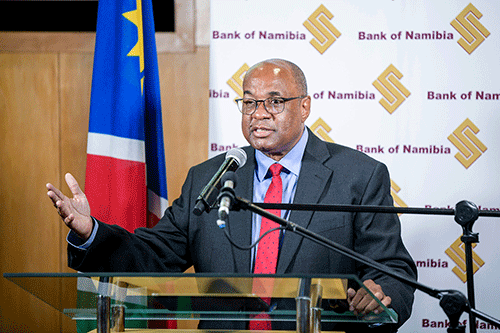In the wake of the Covid-19 pandemic, financial institutions globally have increased their holdings of domestic government/sovereign debt, thereby tightening the linkage between the health of the financial system and the level of sovereign debt or the “financial sector-sovereign nexus”.
According to Bank of Namibia governor Johannes !Gawaxab, the largest four banks in Namibia held 14.1% of the sovereign debt stock as at December 2021. Moreover, non-bank financial institutions’ (NBFIs) holdings of government debt were much higher at 35.5% over the same period.
This relationship demonstrates the limited availability of investment instruments in Namibia. The risks emerging from this nexus are being closely monitored, and diversifying investment opportunities alongside sustained fiscal consolidation will go a long way towards easing this risk, going forward, he observed.
In his remarks last week during the launch of the 2021 financial stability report, !Gawaxab stated that in emerging markets, banks’ holdings of government debt as a percentage of their assets increased to a record 17% in 2021.
“The situation in Namibia shows that relative to banks’ total assets, government securities’ holdings by banks stood at 11.8% in December 2021. Similarly, NBFIs had invested 11.8% of their total assets in government securities over the same period,” he said.
The current regulatory environment requires swift and bold interventions to safeguard the stability of Namibia’s financial system. The governor noted that the interventions the two sister regulators took to cushion the impact of the pandemic on domestic regulated entities and their clients have helped avoid what would otherwise have been a catastrophic situation.
“One of the things we have learned from past financial crises is that the inability to process real-time data and act in time can have far-reaching negative consequences for the entire system. In the short-term, the bank will continue to do everything within its mandate to contain inflationary pressure and maintain price stability. Furthermore, the bank will work towards finalising its position on emerging trends and innovations such as cryptocurrencies and central bank digital currencies,” !Gawaxab pointed out.
At the same occasion, deputy governor of the bank Ebson Uanguta said growth in total banking sector assets remained positive, with liquid assets well in excess of the statutory minimum liquid assets’ requirement of 10% of monthly average liabilities to the public for the period under review.
Overall, risks to the banking sector did not appear significant in 2021, therefore posing no real threat to financial stability in Namibia. However, Uanguta said asset quality requires continuous monitoring as well as interventions if and when needed.
“Going forward, risks to the banking sector have the potential to go up in 2022 on the back of potential interest rate hikes due to inflationary pressure and slower-than-expected economic recovery,” warned the deputy governor.
Furthermore, the NBFIs sector remained resilient during 2021, withstanding the effects of Covid-19, rising inflation and the interest rate hikes in various jurisdictions. Total assets grew by 13.9% to N$370.6 billion during 2021. Growth in sectoral assets is attributable to new business, financial markets performance, and increased economic activity as a result of the economic recovery during the period under review. In a similar vein, the NBFI sector remained stable and resilient with funding and/or solvency positions recorded above prudential requirements in 2021, and is expected to remain sound in 2022.


